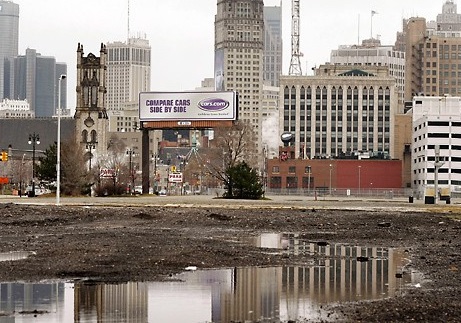Detroit goes BUST! What it means for America and for you.

“Bye, Bye Miss American Pie
Drove my Chevy to the levee, but the levee was dry …”
Don Mclean was not necessarily singing about Detroit, but he certainly could have been. An epithet of all that is American, Detroit was once home of the world’s finest cars, the country’s hippest music, and the greatest manufacturing innovations of the industrial revolution. It is now a deserted landscape of empty factories, abandoned homes, and the rough ghosts of urban decay.
The city filed for bankruptcy last week to become the largest municipality in US History to go broke. Detroit’s astonishing fall can only be fully grasped if we understand its astounding rise, particularly from 1910 to 1950 when America’s “Motor City” was an energetic boomtown cranking out Chevy Corvettes, Plymouth Fury’s, and tail-finned Cadillacs. It boasted newly-automated factories, downtown think-tanks of innovation, and a highway system that was a model for transportation planning and modernization.
In the 1950’s, Detroit was America’s fourth largest city as workers came from across the US in search of good jobs and subsequently pushed its population up over 1.8 million. At one time Motor City had the highest per capita income in the country and was called the “Paris of the West” as its clubs and cafes buzzed with new money, young energy and the rhythm and blues of Motown artists like Marvin Gaye, Smokey Robinson and The Temptations.
So how did it go from one of the country’s most powerful and vibrant cities to the largest municipal bankruptcy in US history? Detroit has been a perfect storm of fiscal failure. From a population collapse, a plummeting tax base, rising crime, high unemployment, poor city management, corruption, soaring pension costs, mounting debt, and massive borrowing …it is a study in urban catastrophe. Motown Records left early on in the decline, as the more recent recession and housing crisis merely sealed the deal.
Detroit has borrowed astonishing amounts of money to pay its bills. Debt dollars have been used to cover everything from public employee pensions, to city health services, to keeping the street lights on at night. With more than 100,000 creditors, the city is currently facing $20 billion in amassed debt.
Here are more sobering facts:
- One third of Detroit is now vacant
- After peaking at 1.8 million, Detroit’s population is now only about 700,000
- There are almost 80,000 abandoned homes within the city’s limits
- Less than half of the city’s remaining residents (over 16) are working
- The violent crime rate in Detroit is five times the national average
- 60 percent of the Detroit’s children are living in poverty
- Only one third of the city’s ambulances are running
- 40 percent of the city’s street lights do not work
To make matters worse, Detroit’s pension collecting residents outnumber the contributing tax base by over 2 to 1. This creates a futile cycle of “borrow and spend” that ultimately leads to insolvency, and it is a new economic reality for many of America’s cities. Detroit joins Stockton, Mammoth Lakes and San Bernardino, California who all filed for protection last year and Jefferson County, Alabama, and Harrisburg, Pennsylvania, who filed in 2011.
So why should we care about all of these deadbeat cities? Municipal insolvencies create uncertainty as bond holders typically demand a greater return on what they perceive to be a greater risk driving interest rates higher and bond values lower. Detroit’s filing could impact communities across the country on the critical question of pensions and specifically whether the retirement funds of public employees are protected or whether America’s many insolvent urban centers should be allowed to restructure their debt. The latter could create a ripple effect for other broke cities, towns and counties with heavy union-based pension obligations.
There is a larger critical lesson in all of this as well … that borrowing has very real limits and reckless spending has very grave consequences. While Detroit’s bankruptcy has raised concerns about other large metropolises like Oakland, Philadelphia, Chicago … it has also begs the question of what is next on the Federal level as US debt approaches $17 trillion and the tenuous debt ceiling and the bloated US budget take center stage again later this year.